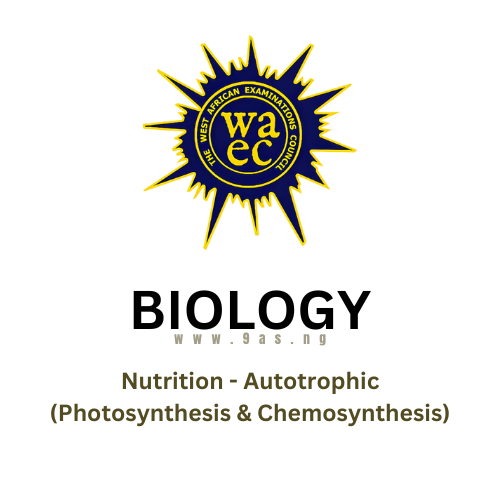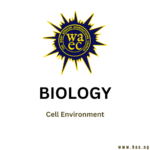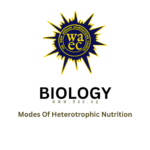OBJECTIVES
1. Pond weeds normally lack thick layers of cuticle because
A. their system of photosynthesis is not efficient.
B. there is no danger of becoming desiccated.
C. their leaves are either dissected or ribbon-shape.
D. there are numerous stomata on their upper epidermis.
2. The overall reaction in glycolysis can be summarized as
A. C6H12O6C3H4O3 + 4H +ATP.
B. C6H12O6-2C3H4O3+4H+2ATP.
C. C6H12O6 →2C3H403 + 4H+ADP.
D. C6H12O62C3H4O3 + 4H+2ADP.
3. In testing for starch in a leaf, the leaf is boiled in alcohol to
A. kill the cells.
B. soften the leaf.
C. enable chemicals penetrate the leaf.
D. decòlourize the leaf.
4. The complex energy-rich organic matter which living organisms need for life is
A. water.
B. air.
C. food.
D. mineral salts.
5. Which of the following functions is associated with calcium in plants? Formation of
A. cell wall.
B. ribosomes.
C. proteins.
D. cell membrane.
6. The source of energy required by plants during food production is
A. photosynthesis.
B. chlorophyll.
C. sunlight.
D. microorganisms.
7. One major difference between plant and animal nutrition is the ability of plants to synthesize
A. food for plants and animals.
B. water for plants.
C. water for animals.
D. food for plants only.
12. The mode of nutrition common to green plants
A. autotrophic
B. heterotrophs
C. holozoic
D. saprophytic
Study the diagram below and answer questions 13, 14, 15

13.The mode of nutrition of the plant in the diagram is
A. photosynthetic and chemosynthetic
B. saprophytic and carnivorous.
C. photosynthetic and carnivorous
D. chemosynthetic and saprophytic
14.The structure labelled I is
A. a pitcher
B. an onion.
C. a flower.
D. a tendril.
15.in which type of soil is the plant found? Soil that is
A poorly aerated.
B. water logged
C. exposed.
D. nitrogen deficient
16. Which of the following groups of organisms do not have members that can be called autotrophs
A. Protists.
B. Mosses.
C. Chlorophyl.
D. Fungi
17. An organism whose source of carbon is inorganic is likely to be a/an
A. heterotrophic organism.
B. autotrophic organism
C. symbiotic organism
D. parasitic organism
18. The major role played by accessory pigments during photosynthesis is to
A. add colour to plants but not to trap light energy
B. trap light mergy that chlorophyll cannot absorb
C transfer energy from chlorophyll to other pigments
D. prevent chlorophyll from absorbing unnecessary light
19. The main raw materials required for photosynthesis are
A. oxygen and water.
B. orygen and carbon dioxide
C. oxygen and chlorophyll
D. carbon dioxide and water
20. The process by which plants manufacture food from carbon dioxide and water using knergy from the sun is called
A. chemosynthesh.
B. synthesis
C. anabolism
D. catabolism
22. Which of the following substances must be present the sold for growth of a healthy green plant
A. Amino acids
B. Carbon,
C. Glucose sab
D. Magnesium ions
23. The importance of the concentration of chloroplast in the polisade layer of the leaf is for maximum exposes to
A. carbon dioxide
B. light
C. water.
D. oxygen
24. The purpose of treating poor soil with lime is to Increase the quantity of
A. nitrogen.
B. phosphorus
C. calcium
D. sulphur.
25. Which of the statements below explains why fertilizers are added to soils?
A. Increasing the hummus content of the soil
B. Improving the water retaining property of the soil.
C. Increasing the nutrient level of the soil
D. Preventing soil erosion.
26. Which of the following statements about photosynthesis is not true?
A. Plants can photosynthesize without an increase in dry weight
B. Carbon dioxide is absorbed by the leaves in bright light.
C. Oxygen is produced during photosynthesis fromn the breakdown of water
D. Photosynthesis occurs in green plants.
27. Micronutrients essential for the synthesis of chlorophyll include
A, iron and potassium
B. iron and magnesium
C. magnesium and calcium
D. magnesium and potassium.
Use the information below to answer questions 28 and 25
A pupil accidentally “watered” a potted plant with concentrated salt solution. After sometime the plant
began to wilt
28. The wilting of the plant is due to the fact that
A, the root hairs die off and can no longer absorb water
B, the salt solution causes faster rate of transpiration leading to the death of the plant cells
C. the salt solution has caused water to be lost from the plant cells leading to loss of turgor
D. the plant tissue has been poisoned by the salt which is absorbed by the plant.
29. Which of the following activities would revive the plant?
A. Covering the plant with dark paper to prevent further water loss from its surfaces
B. Leaving the plant to adapt to the condition
C. Exposing the plant to high concentration of oxygen
D. Adding more water to the soil.
30. The process whereby electrons are emitted from chlorophyll and returned to it unchanged is known as
A. non-cyclic phosphorylation
B. photochemical reaction
C. photophorylation
D. cyclic photophorylation.
31. The oxygen released during photosynthesis is obtained
A. from the catalytic splitting of carbon dioxide in plant tissues.
B. from the breakdown of glucose molecules in cells.
C. during the photolysis of water using energy trapped in chlorophyll.
D. by the excretion of excess oxygen in plant tissues
32. Which of the following pairs of organisms are photosynthetic
A. Amoeba and Paramecium,
B. Volvo and Rhizopus
C. Chlamyaomonas and Euglena.
D. Nostoc and Plasmodiuin
33. Which of the following is an autotrophic mode of nutrition?
A. Chemosynthesis.
B. Saprophytism
C. Parasitism.
D. Symbiosis
34. Raw materials required by green plants to manufacture their food are
A. mainly fluids
B. inorganic substances
C. living materials
D. mainly gases
35. A faster colour change of a dry cobalt chloride paper affixed to the lower surface of a leaf than the upper one, indicates that
A. slight slows down water loss from the upper surface.
B, the lowes surface of the leaf ore stomata.
C. sunlight causes the stomata on the upper surface to close.
D. stomata are not present on the upper surface of a leaf.
36. The first stable product of photosynthesis
A. starch
B. glucose.
C. oxygen
D. water.
37: During which of the following processes is food for animals produce
A. Photosynthesis.
B. Respiration
C. Nutrition.
D. Digestion.
38. Which of the following does not occur during photosynthesis?
A. Energy from sunlight is absorbed.
B. Carbon dioxide is evolved.
C. Glucose is synthesized.
D. Oxygen is given off.
39. Even though some flowering plants contain accessory pigments which give them colours they still contain the pigment
A. melanin.
B. chlorophyll.
C. xanthrophyll.
D. carotene.
40. Autotropic nutrition may be defined in terms of food obtained
A. from other organisms in exchange for some products.
B. by the breakdown of complex substances.
C. by an organism utilizing its own store of energy.
D. by synthesizing simple substances using energy from an external source.
41. All animals are dependent on green plants because plants
A. shelter them from excessive heat from the sun.
B. give them protection from enemies.
C. are used for building Houses, and furniture.
D. manufacture food for animals.
42. The process by which plants manufacture food from carbon dioxide and water, using energy from the sun is termed
A. chemosynthesis.
B. photosynthesis.
C. autotrophism.
D. heterotrophism.
43. Which of the following structures of the leaf contains air
A. Guard Cell.
B. Palisade layer.
C. Intercellular space.
D. Vascular bundle.
44. Study the diagram below. Use it to answer questions.
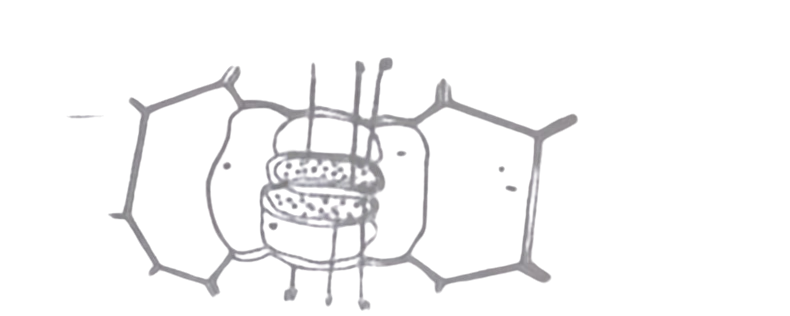
Which of the labelled structures in the diagram are involved with the entry of carbon dioxide for
photosynthesis?
A. I, II and III only.
B. I, II III and VI.
C. I, II, V and VI.
D. I, II, III, and IV.
45. The following are necessary for photosynthesis to take place except
A. chlorophyll.
B. water.
C. Carbondioxide.
D. oxygen.
46. Which of the following is not required for primary production to occur in plants?
A. Chlorophyll.
B. Sugar.
C. Water.
D. Carbon dioxide.
47. The stomata of a leaf performs the same function as
A. spiracles of insects.
B. trachea of toads.
C. pharynx of man.
D. liver of man.
48. The examples of autotrophic organisms include the following except
A. Euglena.
B. Chlamydomonas.
C. Hydra.
D. Spirogyra
The diagram below is the transverse section of a leaf. Study and use it to answer questions 49-51.
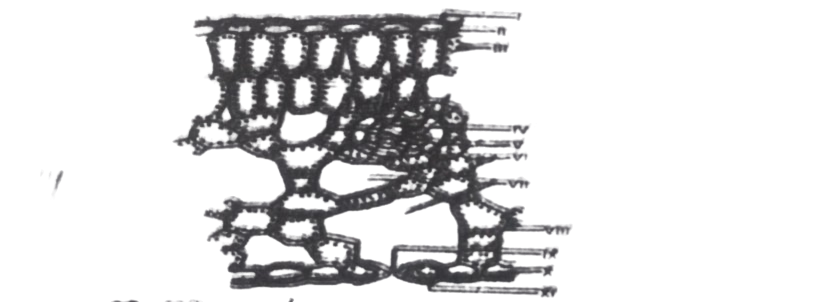
49. Carbon dioxide enters the leaf through the structure labelled
A. I.
B. II.
C. IX.
D. X.
50. Manufactured food is transported from the leaves through the structure labelled
A. IV.
B. V.
C. VI.
D. VII.
51. The pallisade cells are the structures labelled
A. III.
B. IV.
C. VI.
D. VI.
52. In which of the following processes is light energy converted to ATP?
A. Osmosis.
B. Transpiration.
C. Chemosynthesis
D. Photosynthesis.
53. Which of the following is an evidence of photosynthesis?
A. Absorption of light.
B. Formation of starch.
C. Availability of carbon dioxide.
D. Splitting of water molecules
54. Which of the following organisms is a chemo-autotroph?
A. Virus.
B. Bacteria
C. Paramecium.
D. Euglena.
55. Carbon dioxide enters the stomata during photosynthesis through the process known as
A. osmosis.
B. active transport.
C. diffusion.
D. Inhalation.
56. Which of the following groups of compounds are products of the light stage of photosynthesis?
I. Ribulose bi-phosphate (RuBP)
II. Nicotin amide di-phosphorous (NADPH)
III. Oxygen (O)
IV. Adenosine Triphosphate (ATP)
A. I, II and III.
B. I, II and IV.
C. II, III and IV.
D. I, II, II and IV.
57. Which of the following is considered to be the first product of photosynthesis
A. Protein.
B. Energised chlorophyll.
C. Hydroxyl ions.
D. Starch.
58. Which of the following solutions is suitable for removing chlorophyll in a green leaf?
A. Millon’s reagent.
B. Methylated spirit.
C. Benedict solution.
D. Fehling’s solution.
59. At the end of photosynthesis, the green leaf is tested for starch and not glucose, because
A. the glucose is used up immediately to provide energy for the needs of the leaves.
B. the glucose formed is immediately converted to starch.
C. starch is stored only in leaves.
D. there are no chemicals for glucose test in leaves.
60. Which of the following equations is not associated with photosynthesis?
A. H2 => H+ OH.
B. C6H12O2 => 2C2H2OH+2CO2
C. CO₂+[4H] => CH₂O+H₂O.
D. 4[OH] => 2H2O+O2
61. Which of the following conditions is not necessary for photosynthesis to occur in plants?
A. There must be light.
B. There must be xylem tissue used to conduct water.
C. There must be chlorophyll to trap radiant energy.
D. Carbon dioxide must be present.
62. Autotrophs are also described as
A. consumers.
B. decomposers
C. carnivores.
D. producers.
63. In photosynthesis, the following processes are part of the light reaction except
A. transfer of radiant energy which reduces a co-factor.
B. absorption of radiant energy by chlorophyll.
C. utilization of the energy in the electron transfer chain to form ATP.
D. formation of glucose using energy from NADPH.
64. During photosynthesis, light energy is always absorbed by the
A. shoot.
B. water.
C. chlorophyll.
D. enzyme.
Use the information below on factors required during photosynthesis to answer questions 65 and 66
I. CO2
II. Chlorophyll
III. Water
IV. ATP
V. NADPH2
65. Which of the above factors can be a limiting factor for the process to proceed?
A. I and II only.
B. I and III only.
C. I and IV only.
D. I, III and IV only.
66. The factors required for the dark phase of photosynthesis are
A.III and IV only.
B. III and V only
C. III, IV and V only.
D. IV and V only.
67. The correct equation for photosynthesis is
A. C6H12O6+6O2 —————> 6CO2+6H2O
B. CO2+H2O —————> C6H12O2+O2
C.6CO2+6H2O —————-> C6H12O6+6O2
D. 6CO2+6H2O ——————> 6C6H12O6+6O2
68. Which of the following forms of energy is utilized during photosynthesis?
A. Potential.
B. Kinetic.
C. Solar
D. Chemical.
70. Light is excluded from a water culture experiment in order to
A. prevent overheating of the roots.
B. enable the roots to grow straight down.
C. prevent ionization of water molecules
D. prevent the growth of algae.
71. The first stable product of photosynthesis is
A. Starch.
B. Fructose.
C. Glucose.
D. Sucrose
The diagram below is an illustration of the growth of a plant in a water culture. After a few days, the solution turned green and the plant died. Use it to answer questions 72 and 73.
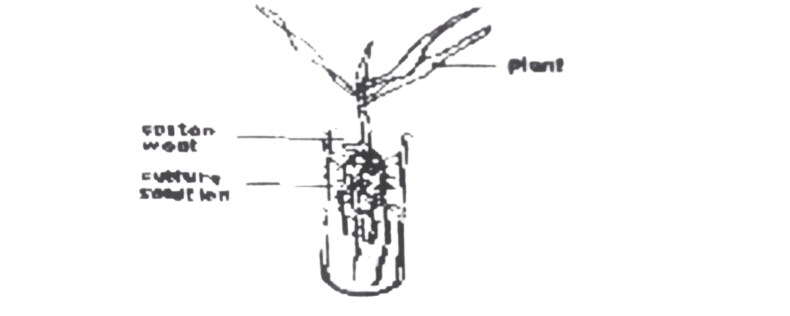
72. What precaution should have been taken to prevent the solution from turning green?
A. Use a non-green plant for the experiment
B. Aerate the solution daily
C.Cover the culture vessel with opaque paper
D. Keep cotton wool around the seedling to make it dry
73. The death of the plant was likely caused by
A. supply of nutrients to the plant.
B. inadequate supply of water to the plant.
C. algal growth in the solution the used up the nutrients.
D. inability of the plant to make food due to lack of sunlight
74. Which of the following factors is not necessary for photosynthesis?
A. Water.
B. Carbon (IV) oxide.
C. Wind.
D. Sunlight.
75. Autotrophic nutrition is a process whereby an organism obtains food
A. by utilizing its stored energy.
B. by synthesizing simple substances using energy.
C. from other organisms in exchange for some products
D. in a synthesized form, from other living organisms
76. The process that takes place at the light stage of photosynthesis is
A. splitting of water molecules to form hydrogen ions.
B. reduction of carbon (IV) oxide form carbohydrate.
C. formation of two molecules of phosphoglyceric acid.
D. breaking down of ATP molecules to produce energy.
77. An evidence of the occurrence of photosynthesis in a experiment is the
A. release of carbon (IV) oxide.
B. release of oxygen.
C. formation of water molecules
D. formation and release of fructose.
78. Which of the following processes does not occur during photosynthesis?
A. Carbon (IV) oxide is evolves
B. Water is split.
C. Oxygen is evolved.
D. Energy from sunlight is absorbed.
79. Stunted growth and small yellow leaves in plants are symptoms of the deficiencies of
A. sulphur.
B. iron.
C. magnesium.
D. nitrogen.
THEORY
1. (a) What are autotrophs (b) Name two unicellular organisms that are autotrophs
2. (a) Explain the following modes of nutrition which occur in plants: (i) Autotrophic (ii) Carnivorous (iii)
Chemosynthetic. (b) Give one example each of a plant which undergoes the modes of nutrition listed in 2(a)above
3. Name three parts of plants in which food can be stored and give one example in each case.
4. (a) What is photosynthesis? (b) List (i) four external factors (ii) Two internal factors; that affect the rate of photosynthesis, (c) List the major products of the light dependent stage of photosynthesis, (d) State the importance of each of the products listed in (c) above. (e) Explain why there are no green plants at the lower depths of some lakes. (f) State why decomposers are important to flowering plants.
5. Explain how the leaf of a flowering plant is adapted for photosynthesis.
6. (a) State one way in which chlorophyll is important in plants. (b) Name two macro-elements that are required for the formation of chlorophyll in plants. (c) State one deficiency symptom of each macro-element named in (b).
7. Describe the mode of nutrition in a named carnivorous plant.
8. Explain briefly how the palisade cell relate to its functions.
9. (a) Explain briefly chemosynthesis as a mode of nutrition. (b) Give two examples of organisms that carry out chemosynthesis.
10. (a) State four modes of nutrition in plants (b) Outline the process involved in the light and dark reactions of photosynthesis.
11. Describe an experiment to demonstrate that oxygen is released by green plants during photosynthesis.
12. (a)(i) Name the two stages involved in photosynthesis (ii) Write an equation to represent the first stage of photosynthesis (b) List six modes of nutrition in organisms.
13. (a) Describe an experiment to show that green plants require sunlight for photosynthesis. (Details of test for starch not required) (b) What other conditions are necessary for photosynthesis? (c) Name the part of a dicotyledonous leaf where most food is manufactured, giving reasons. (d) What happens to the manufactured food?
14. Explain briefly the reason light energy is considered a limiting factor in the production of food by autotrophs.
15. (a) List three food substances that plants manufacture from glucose. (b) Make a diagram, 6 cm to 8 cm long of an experimental set-up to show that oxygen is produced during photosynthesis.
16. (a) Complete the table below by ticking the appropriate group to which each of the listed elements required by plants belongs.
| Element | Group | |
| Micro-element | Macro-element | |
| Hydrogen | ||
| Copper | ||
| Magnesium | ||
| zinc | ||
| Phosphorus | ||
| Manganese | ||
| Boron | ||
| Nitrogen | ||
| Carbon | ||
| Oxygen | ||
17. Explain briefly the mode of nutrition in carnivorous plants.

